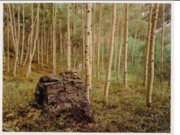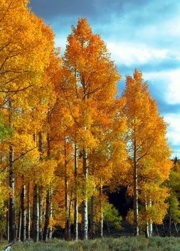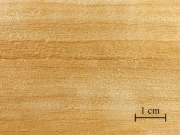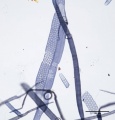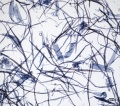Difference between revisions of "Aspen"
| (11 intermediate revisions by the same user not shown) | |||
| Line 1: | Line 1: | ||
| − | [[File: | + | [[File:MFA-Aspen.tif|thumb|Aspen Lightning, Frosco by John Pfahl, 1977]] |
== Description == | == Description == | ||
| − | A deciduous hardwood tree of the willow family, such as ''Populus tremula'' (European quaking aspen), ''P. tremuloides'' (American quaking aspen) and ''P. alba'' (white aspen). Aspen trees are native to northern Europe, Asia and North America in high altitude areas such as mountains or high plains. The fast-growing aspen trees have a smooth, pale gray bark and circular leaves with toothed edges. The soft, yellowish-white timber has a uniform, straight grain with almost no distinction between the summerwood and springwood. Aspen poplar wood has large, evenly-distributed pores that produce a soft fibrous texture. It cannot be planed smooth. Aspen wood is easy to work, but weak, | + | A deciduous hardwood tree of the willow family, such as ''Populus tremula'' (European quaking aspen), ''P. tremuloides'' (American quaking aspen) and ''P. alba'' (white aspen). Aspen trees are native to northern Europe, Asia and North America in high altitude areas such as mountains or high plains. They are fast-growing and thrive best in open sunlight without competing tree species. The fast-growing aspen trees have a smooth, pale gray bark and circular leaves with toothed edges. The soft, yellowish-white timber has a uniform, straight grain with almost no distinction between the summerwood and springwood. Aspen poplar wood has large, evenly-distributed pores that produce a soft fibrous texture. It cannot be planed smooth. Aspen wood is easy to work, but weak, and produces a disagreeable odor when wet. The lightweight, spongy wood is generally used for matches, fruit boxes and paper pulp. The shredded wood is used for excelsior (wood wool), packing and stuffing. The dry timber is resistant to rotting and warping. |
| − | + | [[File:image 9-aspen.jpg|thumb|Aspen]] | |
| − | [[File:Aspen.jpg|thumb|Aspen (Silver poplar) | + | [[File:Aspen.jpg|thumb|Aspen (Silver poplar)(''Populus alba'')]] |
| − | |||
| − | (''Populus alba'')]] | ||
== Synonyms and Related Terms == | == Synonyms and Related Terms == | ||
''Populus tremula; Populus tremuloides; Populus alba''; peuplier tremble (Fr.); Espe (Deut.); Pappel (Deut.); Zitterpappel (Deut.); pioppo tremula (It.); alamo temblon (Esp.); cran critheach (Gaelic); choupo (Port.); aspen poplar; trembling aspen; trembling poplar; quivering aspen; shaking aspen; popple | ''Populus tremula; Populus tremuloides; Populus alba''; peuplier tremble (Fr.); Espe (Deut.); Pappel (Deut.); Zitterpappel (Deut.); pioppo tremula (It.); alamo temblon (Esp.); cran critheach (Gaelic); choupo (Port.); aspen poplar; trembling aspen; trembling poplar; quivering aspen; shaking aspen; popple | ||
| − | == | + | == Working properties == |
| + | * Aspen wood is lightweight, spongy and easy to work, but weak. | ||
| + | * The undried wood is prone to warping and produces a disagreeable odor. | ||
| − | Freshly cut wood is full of sap and will not float or will not burn. | + | ==Physical and Chemical Properties== |
| − | + | * Aspen wood does not release phenols, but is thought to cause respiratory ailments in some animals | |
| − | Light colored. Rings: obscure. Pores:large. Grain:invisible. Rays:obscure. Soft; lightweight; spongy | + | * Freshly cut wood is full of sap and will not float or will not burn. |
| − | + | * Density = 28 ppcf | |
| − | + | * Specific gravity = 0.45 | |
| − | + | * Light colored. Rings: obscure. Pores:large. Grain:invisible. Rays:obscure. Soft; lightweight; spongy | |
| − | |||
| − | |||
| − | |||
| − | |||
| − | |||
| − | |||
Paper fiber type: hardwood, diffuse porous. Using transmitted light microscopy, pulp is identified by medium to long vessels with alternate crowded pitting on one side. Ray parenchyma pits are alternate and occur in horizontal groups. Perforations are simple. Appearance with [[Graff "C" stain]]: dark blue, but varies with bleaching. Average dimensions of fibers: length, 0.9mm. 19μm wide. Common pulping method: [[kraft process|kraft]]. | Paper fiber type: hardwood, diffuse porous. Using transmitted light microscopy, pulp is identified by medium to long vessels with alternate crowded pitting on one side. Ray parenchyma pits are alternate and occur in horizontal groups. Perforations are simple. Appearance with [[Graff "C" stain]]: dark blue, but varies with bleaching. Average dimensions of fibers: length, 0.9mm. 19μm wide. Common pulping method: [[kraft process|kraft]]. | ||
| − | |||
| − | |||
| − | |||
| − | |||
==Additional Images== | ==Additional Images== | ||
| Line 38: | Line 28: | ||
</gallery> | </gallery> | ||
| − | == | + | ==Resources and Citations== |
| − | |||
| − | |||
| − | |||
| − | |||
| + | * Schoch, W., Heller, I., Schweingruber, F.H., Kienast, F., 2004:[http://www.woodanatomy.ch/ Wood anatomy of central European Species]: Aspen, [http://www.woodanatomy.ch/species.php?code=PPTR Populus tremula L.] | ||
| + | * Wikipedia, [https://en.wikipedia.org/wiki/Aspen Aspen] accessed April 2020 | ||
* H.L.Edlin, ''What Wood is That?'', Viking Press, New York, 1969 | * H.L.Edlin, ''What Wood is That?'', Viking Press, New York, 1969 | ||
| − | |||
* G.S.Brady, ''Materials Handbook'', McGraw-Hill Book Co., New York, 1971 Comment: p. 75 | * G.S.Brady, ''Materials Handbook'', McGraw-Hill Book Co., New York, 1971 Comment: p. 75 | ||
| − | |||
* ''Van Nostrand's Scientific Encyclopedia'', Douglas M. Considine (ed.), Van Nostrand Reinhold, New York, 1976 | * ''Van Nostrand's Scientific Encyclopedia'', Douglas M. Considine (ed.), Van Nostrand Reinhold, New York, 1976 | ||
| − | |||
* Random House, ''Webster's Encyclopedic Unabridged Dictionary of the English Language'', Grammercy Book, New York, 1997 | * Random House, ''Webster's Encyclopedic Unabridged Dictionary of the English Language'', Grammercy Book, New York, 1997 | ||
| − | |||
* ''The American Heritage Dictionary'' or ''Encarta'', via Microsoft Bookshelf 98, Microsoft Corp., 1998 | * ''The American Heritage Dictionary'' or ''Encarta'', via Microsoft Bookshelf 98, Microsoft Corp., 1998 | ||
| − | |||
* Gordon Hanlon, contributed information, 1998 | * Gordon Hanlon, contributed information, 1998 | ||
| − | |||
* Marja-Sisko Ilvessalo-Pfäffli. ''Fiber Atlas: Identification of Papermaking Fibers'' (Springer Series in Wood Science). Springer, 1995. | * Marja-Sisko Ilvessalo-Pfäffli. ''Fiber Atlas: Identification of Papermaking Fibers'' (Springer Series in Wood Science). Springer, 1995. | ||
| − | |||
* Walter Rantanen. "Fiber ID Course." Integrated Paper Services. June 2013. Lecture. | * Walter Rantanen. "Fiber ID Course." Integrated Paper Services. June 2013. Lecture. | ||
[[Category:Materials database]] | [[Category:Materials database]] | ||
Latest revision as of 14:16, 17 November 2024
Description
A deciduous hardwood tree of the willow family, such as Populus tremula (European quaking aspen), P. tremuloides (American quaking aspen) and P. alba (white aspen). Aspen trees are native to northern Europe, Asia and North America in high altitude areas such as mountains or high plains. They are fast-growing and thrive best in open sunlight without competing tree species. The fast-growing aspen trees have a smooth, pale gray bark and circular leaves with toothed edges. The soft, yellowish-white timber has a uniform, straight grain with almost no distinction between the summerwood and springwood. Aspen poplar wood has large, evenly-distributed pores that produce a soft fibrous texture. It cannot be planed smooth. Aspen wood is easy to work, but weak, and produces a disagreeable odor when wet. The lightweight, spongy wood is generally used for matches, fruit boxes and paper pulp. The shredded wood is used for excelsior (wood wool), packing and stuffing. The dry timber is resistant to rotting and warping.
Synonyms and Related Terms
Populus tremula; Populus tremuloides; Populus alba; peuplier tremble (Fr.); Espe (Deut.); Pappel (Deut.); Zitterpappel (Deut.); pioppo tremula (It.); alamo temblon (Esp.); cran critheach (Gaelic); choupo (Port.); aspen poplar; trembling aspen; trembling poplar; quivering aspen; shaking aspen; popple
Working properties
- Aspen wood is lightweight, spongy and easy to work, but weak.
- The undried wood is prone to warping and produces a disagreeable odor.
Physical and Chemical Properties
- Aspen wood does not release phenols, but is thought to cause respiratory ailments in some animals
- Freshly cut wood is full of sap and will not float or will not burn.
- Density = 28 ppcf
- Specific gravity = 0.45
- Light colored. Rings: obscure. Pores:large. Grain:invisible. Rays:obscure. Soft; lightweight; spongy
Paper fiber type: hardwood, diffuse porous. Using transmitted light microscopy, pulp is identified by medium to long vessels with alternate crowded pitting on one side. Ray parenchyma pits are alternate and occur in horizontal groups. Perforations are simple. Appearance with Graff "C" stain: dark blue, but varies with bleaching. Average dimensions of fibers: length, 0.9mm. 19μm wide. Common pulping method: kraft.
Additional Images
Resources and Citations
- Schoch, W., Heller, I., Schweingruber, F.H., Kienast, F., 2004:Wood anatomy of central European Species: Aspen, Populus tremula L.
- Wikipedia, Aspen accessed April 2020
- H.L.Edlin, What Wood is That?, Viking Press, New York, 1969
- G.S.Brady, Materials Handbook, McGraw-Hill Book Co., New York, 1971 Comment: p. 75
- Van Nostrand's Scientific Encyclopedia, Douglas M. Considine (ed.), Van Nostrand Reinhold, New York, 1976
- Random House, Webster's Encyclopedic Unabridged Dictionary of the English Language, Grammercy Book, New York, 1997
- The American Heritage Dictionary or Encarta, via Microsoft Bookshelf 98, Microsoft Corp., 1998
- Gordon Hanlon, contributed information, 1998
- Marja-Sisko Ilvessalo-Pfäffli. Fiber Atlas: Identification of Papermaking Fibers (Springer Series in Wood Science). Springer, 1995.
- Walter Rantanen. "Fiber ID Course." Integrated Paper Services. June 2013. Lecture.
